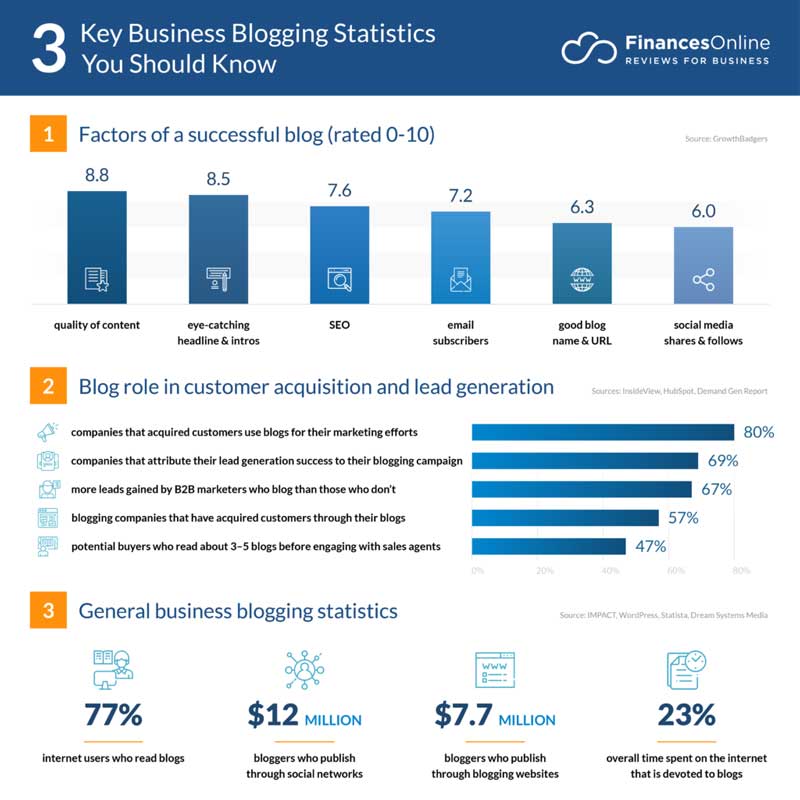Most companies around the globe who have embraced the tenets of content marketing have made blogging an integral part of their content offerings. But for a blog to pull its weight and be a valuable component of your marketing mix, you’re going to have to do more than publishing an occasional post on some industry topic, or about your latest award.
All types of businesses blog, and as a result, there is an ocean of blog posts. Having your blog stand out and getting it noticed, rather than having it sink without a trace, is more of a challenge than many businesses realize.
A good blog post should engage, pique interest, and steer decision-making. This can then lead to sales, contracts, brand awareness, and enhanced reputation.
Image Source: FinancesOnline.com
Successful blog properties have longevity and bring consumers back to read them again. But how do you create a high-value business blog?
The good news is there are countless success stories that have helped us nail down the best practices. And none of those practices involve aimlessly publishing content and hoping for the best.
Regardless of your company size, industry, or product/service offerings, you can launch and run a successful business blog provided you have a thoughtful strategy and effective blog management.
Develop a Blog Management Strategy
So, as we’ve touched on, business blogging isn’t an afterthought or an add-on. A blog introduces a rich, engaging stream of fresh content to your website that will drive return visits from interested parties, and new visitors who are searching for solutions.
But the best business blogs have a clearly defined purpose. They have a well-defined strategy that involves research, planning, and process documentation. It’s not just a list of topics you want to cover. Furthermore, running an engaging staff meeting to align your team with the process and strategy is also an essential part of managing a blog.
You’ll also need to research and compile keywords that fit with both the subject and promotional aspects of your products and services. It is critical to consider who your target audience is. Learn about their wants and interests.
Let’s break this down in more detail.
The Elements of Blog Management
Planning your blog output is fundamental in offering value to your audience. People often read blogs to find answers to a question or look for explanations on areas of interest where they lack knowledge.
For example: if your niche is, say, cloud storage, you might create a blog post that addresses its challenges, something like: common cloud migration challenges. Similarly, if you build websites, you might blog about website design trends and include a website design proposal template. In doing so, you anticipate the public’s interests and needs, and you meet them head-on with your blog content.
Audience
Knowing your audience is a vital part of blog management. This is true of any element of your marketing strategy. We’ve talked about meeting needs and covering areas of interest for your potential audience. But there is also style and tone to consider.
One way to gauge this is to look at traffic to your blog posts, but you can also get personal, and ask those engaging online with your company about what they enjoy, prefer, and even dislike about your blog offering.
Getting feedback via short surveys or questionnaires will allow you to tweak or reshape content so that it better chimes with your audience and keeps them coming back for more.
For example, you might post content that explains a technical area of your field like a post on formstack workflow integrations. You can follow this up with a questionnaire to find out if there are any other technical areas your audience is keen to read about.
Focus
Being too narrow in pumping out blog posts that ram home a point you are keen to deliver is counterproductive. But straying too far from your niche is also a mistake.
If you deviate too far from your market niche, you risk a loss of focus and therefore brand identity. If you supply hosted phone solutions with multiple phone numbers for companies, you want most of your content to revolve around telecommunications. You don’t want to branch out too far away from your core business activity.
Keeping focused also applies to the amount of information you put across in your blog. It’s tempting to stuff in as much information as possible to attract traffic, but in trying to reel in more pairs of eyes, you can end up disengaging or boring the pair of eyes that have found and are happily reading your blog.
In short, keep focused. You shouldn’t simply dump information, you need to make it engaging.
Quality
If a piece of content is well-written enough, almost any topic can be interesting. In searching for highly-skilled writers and before you hire freelance writers, it’s helpful to dig into your competitors’ blogs and read as many posts as possible. Identify which posts worked well and which didn’t. Think about the ways in which they engaged or entertained the reader, or didn’t.
Was it the choice of topics? Was it the writing style? Quality is essentially a case of making sure something relevant to your business is well-written and interesting for consumers to read.
There’s an awful lot of content out there, and not all good. Getting the length of the blog right is part of the overall quality. Short posts with little information can be just as bad as long posts stuffed with too much.
Good grammar and syntax are also vital. Reading a crudely put together piece with terrible punctuation is a big turn-off and undermines your professionalism as a company. Blog content must be polished and professional.
Image Source: FinancesOnline.com
Variety
When your business is in a specialized niche, it’s easy to get repetitive with your blog posts. Even if your articles deal with similar or related topics, ensure that each blog post contains a new bit of information or generates ideas for follow-up posts. By doing so, you will keep things varied and interesting.
It could even be that if you have a comments feature, your audience itself will ask questions or make observations that will inspire you to create a follow-up piece.
For example, you might have a piece on how to effectively organize in-house training. This might inspire your audience to ask for a training proposal example to help readers successfully plan their training. These questions are a gift — you know just what your next blog subject should be.
It’s also important to internally link related posts together, as this drives even more traffic and engagement. If all your blogs are too similar, your audience will feel cheated by following a link to read something that sounds virtually identical to something they have just read.
Keywords and SEO
Updating your website as often as you can will grab Google’s attention. Regular blogging can play a big role in this. One common method for generating ideas for new blog content is to use keyword research tools to discover the exact keywords your target audiences use in their searches. What relevant keywords are you not currently ranking or getting any traffic for? Make a list and start planning new blog posts that cover those topics.
You can also use tools like Google Search Console to analyze the keywords that are already driving traffic to your site, and your current ranking position for each. In many cases, you can significantly improve your ranking position for specific keywords when you write about those keywords often.
A Consistent Schedule
A key part of blog management is sticking to a consistent publishing schedule. If you identify a sustainable blogging frequency and proactively plan your posts, blogging will be a long-term activity rather than a flash in the pan that becomes unsustainable.
It’s sad to see bloggers that start strong, but then vanish after a while due to the burden of regularly publishing. You see it on company blogs as well. You check out their blog only to find that they haven’t posted anything in months.
You need a proactive plan and a process that makes it sustainable. Make sure your team has access to your blog content calendar, is aware of their individual responsibilities, and knows that hitting publishing deadlines is important. Success is all about consistency.
Utilizing a blog management tool is certainly a big help here. A content operations tool like DivvyHQ provides everything that a blog team needs, including: idea storage, a blog strategy framework, a sharable calendar interface, customizable workflows, and automated notifications to keep everyone accountable.
Stand Out From The Crowd
So, we’ve seen that blogging isn’t easy, and it takes time and commitment. However, you can elevate your brand and website with carefully thought out topics that include well-researched keywords, are professionally written, and are logically scheduled.
Putting yourself in the customer’s shoes is critical. If you want to blog about how to use a business contract template, try searching for similar blogs and make sure your post has an edge over what’s already out there.
Like most areas of business and life, quality counts, and making sure your blog management is well-organized is the way to make your blogs stand out from the crowd.
For more great tips, tricks, and how-to’s, subscribe to the DivvyHQ blog today!





